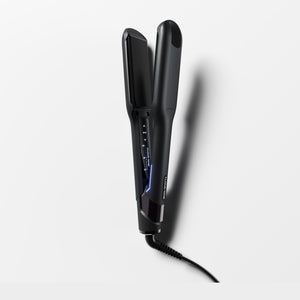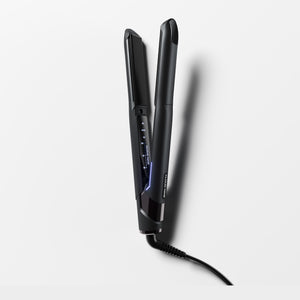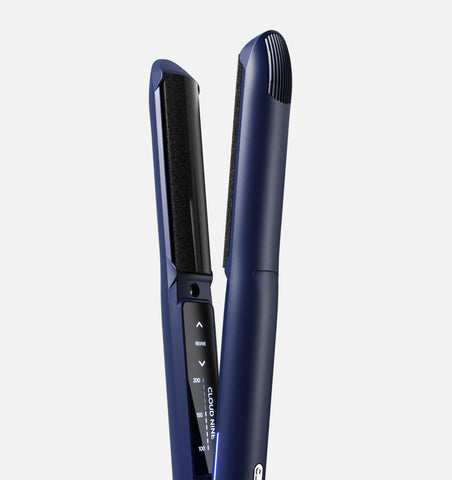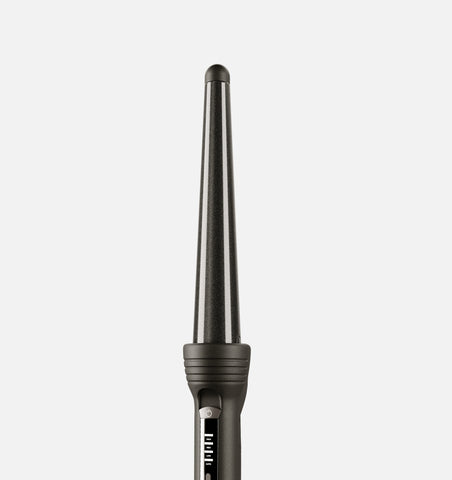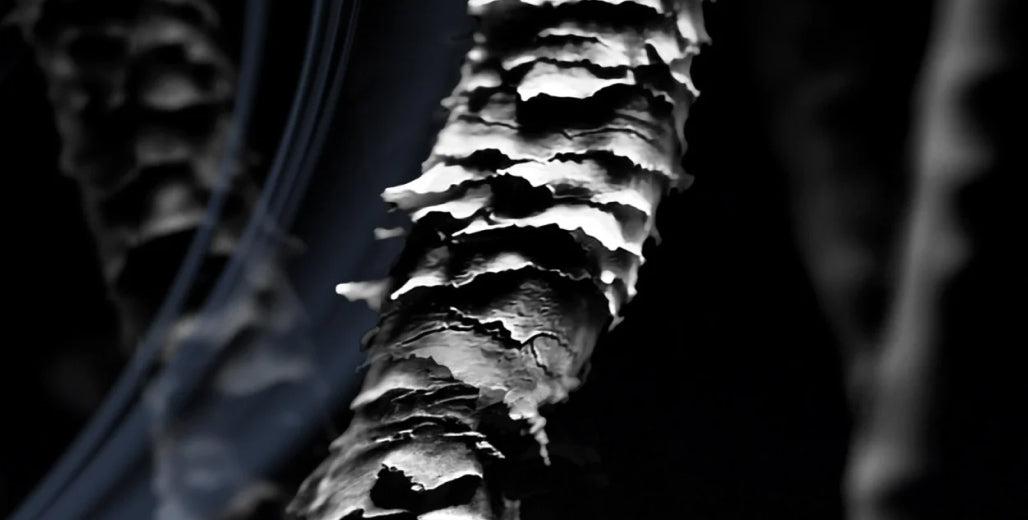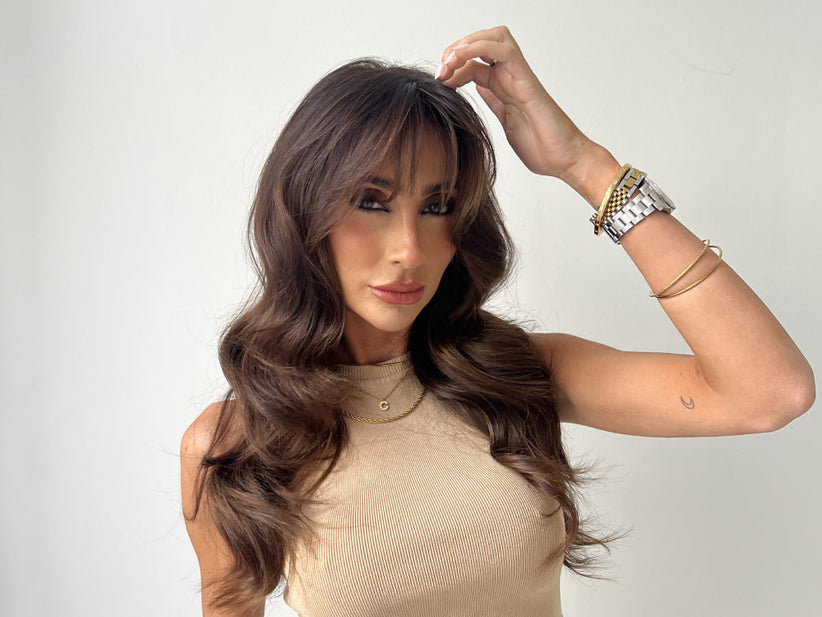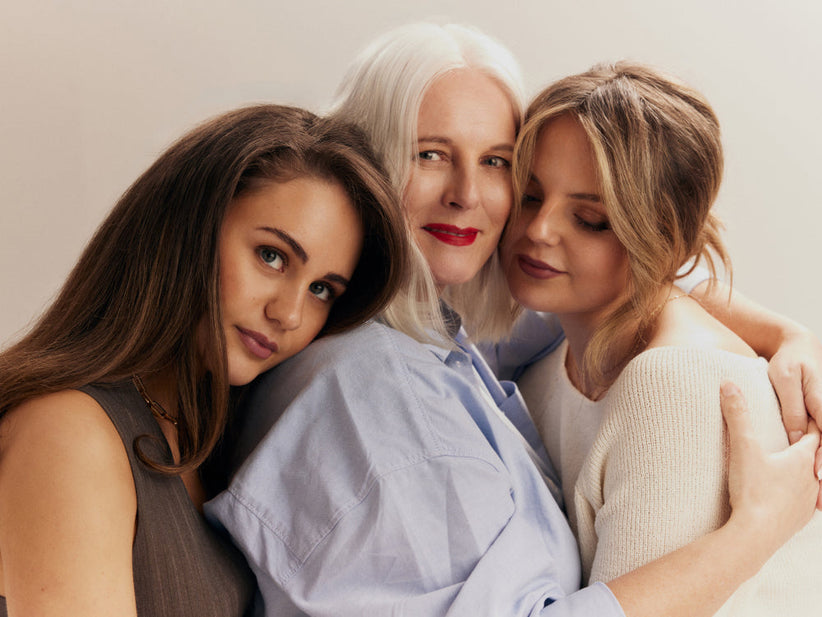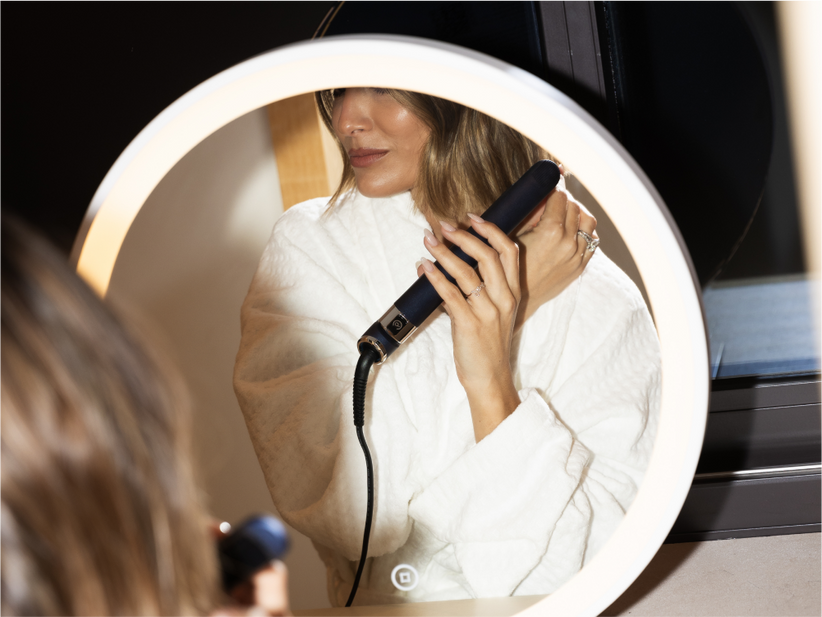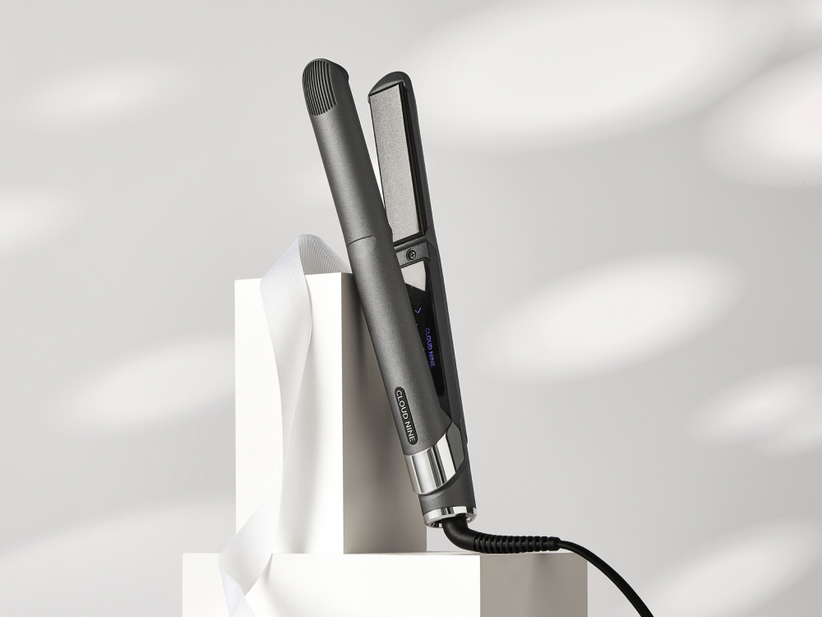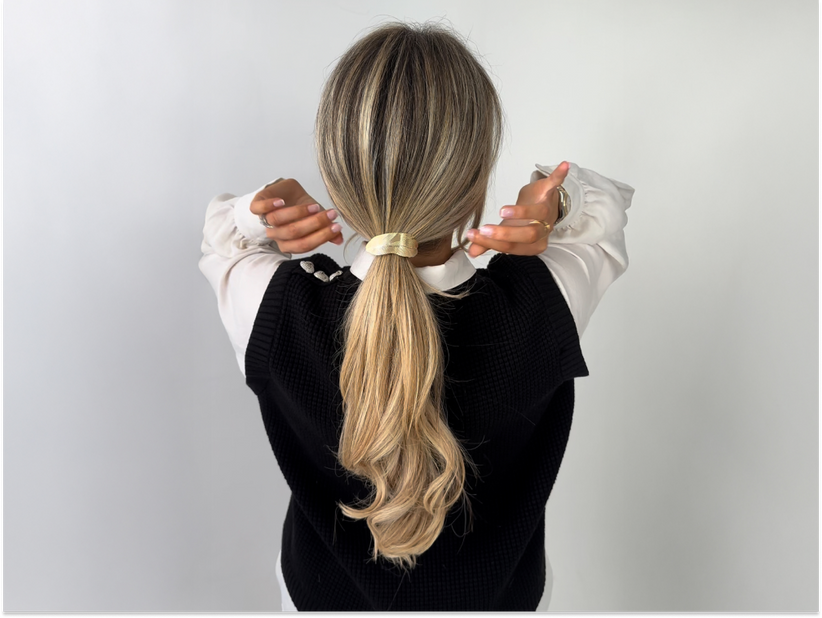If you’re tired of seeing more hair in your brush than on your head, you’re in the right place. In this guide, we’ll unravel the mystery of hair breakage – uncovering the common causes and sharing tried-and-tested solutions to keep your hair strong and healthy. Plus, we’ll tackle some frequently asked questions to make sure you’re armed with all the knowledge you need to battle breakage.
HAIR BREAKAGE: KEY TAKEAWAYS
- Hair breakage can occur at various points on the hair strand, and in different places on the head, depending on the cause of the breakage.
- Split or broken hair strands can be caused by a range of factors, including diet, products, hair routine, hair styling, life factors and sleep.
- The best anti-hair breakage products include low-temperature heated styling tools, detangling brushes and moisturising conditioning treatments.
- It’s possible to minimise breakage by picking the right products and tools for your hair type.
WHAT IS HAIR BREAKAGE?
Hair breakage happens when your hair strands get weak and literally break off, often leaving you with split ends, frizz, and a general feeling that your hair just isn't as luscious as it could be. It's perfectly normal to lose 50-100 hairs every day, which is just natural shedding from the root. Breakage, on the other hand, is when the hair snaps off somewhere along the shaft, usually due to things like heat styling at a temperature that’s too high for your hair type, harsh chemicals, or even rough handling (yes, we're looking at you, super-tight ponytails). But with a bit of extra TLC and the right products, you can help your hair stay healthy and breakage-free.
HOW TO TELL IF YOU HAVE HAIR BREAKAGE
Wondering if your hair is suffering from breakage? It can be tricky to distinguish breakage from regular shedding, but there are a few tell-tale signs to look out for.
Frizzy, dull hair
One of the first signs of hair breakage is frizz. If your hair seems constantly frizzy and lacks its usual shine, it might be because the strands are breaking and creating a rough texture. Healthy hair cuticles lie flat, giving your hair a smooth and shiny appearance. When they’re damaged and raised, your hair can look dull and feel rough. Read our guide about how to manage frizzy hair.
Ragged, thinning ends
Take a closer look at the ends of your hair. Are they thin and ragged, with lots of split ends? This is a classic sign of hair breakage. When your hair breaks, it often does so at different lengths along the strand, leading to thinning ends that taper off rather than appearing blunt and healthy. Check out how you can volumise thin and thinning hair.
Uneven strand lengths
If you notice that your hair seems to be growing unevenly, with strands of varying lengths throughout, this could be another sign of breakage. Healthy hair typically grows at a consistent rate, so when you see a lot of shorter, broken pieces mixed in with longer strands, it’s a sign that your hair is experiencing breakage along the way.
WHERE HAIR BREAKAGE CAN OCCUR AND WHAT IT MIGHT LOOK LIKE
Hair breakage can happen at various points along the hair strand. Spotting where it's occurring can help you tailor your hair care routine. Here's a breakdown of common areas where breakage might occur and what it typically looks like.
At the crown
Breakage at the crown often results from frequent ponytails, buns, or other updos that put stress on this area. You'll notice shorter, broken strands that stick up, giving your hair an uneven look on top. For those with black hair – specifically type 4c hair – tight styles like braids or twists can cause breakage at the crown.
At the root
Breakage at the root is less common but can happen due to tension from tight hairstyles or over-use of extensions. This type of breakage is particularly noticeable when new hair growth is a lot shorter and doesn't blend well with the rest of your hair. In curly hair, this might present as tight, unruly curls that appear frizzier near the scalp.
On top of the head
Breakage on top of the head can be due to over-brushing, dialling up the temperature when heat styling, or harsh chemical treatments. You'll often see a halo of shorter hairs that are difficult to smooth down. Black hair that undergoes chemical straightening or frequent heat styling at too high a temperature can be especially prone to breakage here.
Around the hairline
Your hairline is delicate and susceptible to breakage from tight hairstyles, friction from hats or headbands, and over-manipulation. This breakage appears as shorter, finer hairs around the edges of your face. If you have curly hair or coily hair, tight styles like cornrows or slicked-back buns can lead to thinning and breakage around the hairline.
At the back of the head
Breakage at the back of the head is often due to sleeping on rough pillowcases or wearing hairstyles that put pressure on the back of your head. You'll see shorter, broken hairs that don't lay flat. Using a satin or silk pillowcase can help reduce friction and prevent breakage here.
At the front of the head
Breakage at the front of the head – think shorter, damaged hairs – can be caused by high and excessive heat when using heated styling tools like straighteners and curling irons. Curly hair is particularly vulnerable to heat damage, which can lead to breakage and uneven curls at the front. Over 80% of people mistreat their hair by straightening with the wrong heat setting. Discover your correct style temperature today by using our Temperature Calculator.
At the ends
The ends of your hair are the oldest and most vulnerable to damage. Split ends and thinning are sure signs of breakage at the tips. Regular trims and moisturising treatments like our Magical Remedy are essential to keep the ends of your hair as healthy as possible. Black hair and curly hair, which can be naturally drier, often experience breakage at the ends if not moisturised properly with nourishing conditioners or oils. Minimise breakage by always using a heat protectant like our Magical Potion before using heated styling tools.
HOW BREAKAGE CAN AFFECT DIFFERENT HAIR TYPES
Due to the delicate makeup of hair, all hair types are prone to breakage, whether your hair is straight, curly, or somewhere in between. However, different hair types tend to break in different ways and patterns.
Straight hair (type 1)
Straight hair might seem sturdy, but it's not immune to breakage. Even though it's sleek, the ends can still split, so be sure to use a lower heat setting when using a heated styling tool.
Wavy hair (type 2)
Wavy hair might look effortless, but it can be prone to snapping – especially if you're too rough with the hairbrush.
Curly hair (type 3)
Curly hair, like black hair, tends to be drier and more susceptible to breakage. The curls can break at the root if styles are too tight, on top of the head from over-manipulation, and at the ends from split ends.
Coily hair (type 4)
Black hair is prone to dryness and breakage due to its coiled structure, which makes it harder for natural oils to travel down the hair shaft. Breakage is most likely to happen at the crown due to tight protective styles, at the root from tension, and at the ends from lack of moisture.
WHAT CAUSES HAIR BREAKAGE?
Diet
Here are some dietary culprits that might be causing your hair to snap, crackle, and break.
Excess protein
Protein is great, but too much can make your hair stiff and brittle. You might want to balance your protein treatments with moisture to keep your hair strong and flexible.
Lack of nutrition
Skipping essential nutrients? Your hair feels it. A balanced diet rich in fruits, veggies, whole grains, and lean proteins keeps your hair resilient and less prone to breakage. Discover more about which nutrients are good for your hair.
Vitamin D deficiency
Get some sun and add vitamin D-rich foods like fatty fish and egg yolks to your diet for healthier hair growth.
Dehydration
Dry hair breaks more easily, and NHS guidelines recommend drinking at least two litres of water each day to help your hair stay hydrated from the inside out. Hydrating hair products can also give your hair a moisture boost. Learn more about the importance of hair hydration.
Low iron
Iron is crucial for healthy hair. Low iron levels can make your hair weak and prone to breaking. Boost your iron intake with spinach, lentils, and red meat.
Hard water
Hard water’s minerals can dry out your hair, leading to breakage. Combat this with a water softener or a clarifying shampoo to keep your hair manageable and strong.
Hair treatments
The products you use on your hair can literally make or break your hair. Here’s how some common products might be causing your hair to snap.
Highlights
While highlights can give you that sun-kissed glow, the bleaching process can weaken your hair, making it more prone to breakage. Make sure to use deep conditioning treatments to restore moisture.
Toner
Toner helps maintain your colour, but it can also dry out your hair if used too frequently. Balance it with hydrating products to keep your hair in top condition.
Dandruff shampoo
Fighting flakes? Some dandruff shampoos contain harsh ingredients that can dry out your hair and scalp, leading to breakage. Go for gentle, moisturising formulas to tackle dandruff without drying out your hair.
Coconut oil
Coconut oil is a great moisturiser, but too much can weigh your hair down and make it greasy, leading to potential breakage. Use it sparingly as a pre-wash treatment to keep your hair strong and shiny.
Gel
Styling gels can hold your look in place, but they often contain alcohol which can dry out your hair and lead to breakage. Choose alcohol-free gels and use them in moderation to avoid stiffness and damage.
Hairspray
Hairspray keeps your style intact, but overuse can make your hair stiff and brittle, causing it to snap. Look for flexible hold sprays and use a light touch to keep your hair in place without the crunch.
Hair routine
Your daily hair routine can impact your hair – and not in the way you want. Watch out for these common habits that might be causing your hair to break. Check out these detox-friendly hair routine tips.
Over-washing
Washing your hair too often strips away natural oils, leaving it dry and prone to breakage. Aim for every other day or every few days and use a gentle shampoo to keep your hair clean without overdoing it.
Under-conditioning
Skipping conditioner or not using enough can leave your hair dry and brittle, making it more prone to breakage. Make sure to use a conditioner that matches your hair type and focus on the mid-lengths and ends where it’s needed most.
Brushing hair
Brushing your hair too often or using the wrong type of brush can cause breakage, especially when wet, or if your hair is prone to tangling. Use a wide-tooth comb or a gentle brush like our Luxury Dressing Brush with soft bristles and only brush when necessary, starting from the ends and working your way up.
Twisting hair
Constantly twisting or fiddling with your hair can weaken the strands and lead to breakage, particularly around the crown and temples. Try to keep your hands off your hair and opt for protective styles like braids or an updo tied with a silk scrunchie to minimise damage.
Wearing your hair up
While ponytails and buns are convenient, wearing your hair up too often can cause breakage around the hairline and at the nape of the neck. Switch up your hairstyles and give your hair a break from tight styles to prevent damage.
Tucking hair behind your ear
Tucking your hair behind your ear might seem harmless but doing it repeatedly can create tension on the strands and lead to breakage. Try to resist the urge to tuck and let your hair flow naturally instead.
Wearing glasses
The arms of your glasses can rub against your hair, causing friction and potential breakage, especially if your hair is fine or prone to tangling. Go for glasses with thinner frames or adjust them to sit more lightly on your head to reduce damage.
Sleeping on one side
Repeatedly sleeping on one side can cause friction and breakage, particularly if your hair is fine or prone to tangling. Switch up your sleeping position or use a satin or silk pillowcase to reduce friction.
Split ends
Split ends weaken your hair and make it more prone to breakage. Regular trims and moisturising treatments like our Magical Remedy can help nourish your hair, preventing split ends and keeping your hair healthy and strong.
Hair styling
How you style your hair is really important when it comes to minimising hair breakage. Watch out for these styling tools and techniques that might be causing breakage.
Rubber bands
Rubber bands and hair bands can snag and break your hair, especially if they have metal clasps. Instead, use snag-free hair ties, silk scrunchies, seamless hair bands or spiral hair ties that are gentle on your hair.
Hair clips
Using hair clips to secure your style can lead to breakage, especially if they're too tight or have sharp edges. Be gentle when clipping and avoid pulling or tugging on your hair.
Banana clips
While convenient for holding your hair in place, banana clips can cause breakage, especially if they're too tight or worn too frequently. Go for looser styles or use them sparingly to minimise damage.
Bobby pins
Bobby pins can snag and break your hair if not used properly. Make sure to open them fully before inserting and avoid sliding them in and out of your hair repeatedly.
Buns
Wearing your hair in tight buns can put stress on your hair and lead to breakage, especially around the hairline. Loosen up your bun and use gentle hair accessories to reduce tightness. Learn about other hair-friendly styles.
Hats
While hats can protect your hair from the sun and weather, wearing them too tightly can cause breakage, especially if they're made of rough materials. Choose hats with soft linings and adjust them to fit comfortably.
Ponytails
Tight ponytails can pull on your hair and cause breakage, particularly around the hairline and at the nape of the neck. Loosen your ponytail and use soft hair bobbles or silk scrunchies to minimise damage.
Scrunchies
While gentler than traditional hair ties, scrunchies can still cause breakage if worn too tightly or used repeatedly in the same spot – looser styles work best.
Braiding hair
While braids can be a protective style, tight braids can cause breakage, especially around the edges and at the roots. Go for looser braids and avoid pulling or tugging on your hair.
Life
Life changes and stages can also impact your hair health, making it more prone to breakage. Here’s our lowdown on the main ones.
Pregnancy
Hormonal changes during pregnancy can affect your hair growth cycle, leading to increased shedding or breakage. Talk to your hairdresser for advice on managing hormonal hair loss during pregnancy, or if you have health concerns, speak to your GP.
Head to our guide to hormonal hair loss for help and advice on dealing with hair changes and hair loss during pregnancy.
Menopause
As hormone levels fluctuate during menopause, you may experience changes in your hair texture and thickness. Focus on gentle hair care and chat to your doctor if you have questions about menopause.
Check out our blog on caring for and styling your hair during menopause.
Stress
Stress can wreak havoc on your hair, leading to breakage and shedding. It can be easier said than done, but practising stress-reducing techniques like meditation, yoga, or deep breathing exercises can really help your hair and overall wellbeing.
Sleep
Sleep can also cause hair to break and snap, and here’s why.
Sleeping with wet hair
Sleeping with wet hair can cause breakage, as wet hair is more prone to damage. Allow your hair to air dry or use a low-heat setting on your hair dryer before getting under the covers.
Sleep mask
The straps of a sleep mask can snag and break your hair, especially if they're tight or made of rough material. Try a satin or silk sleep mask and adjust it to fit comfortably without pulling on your hair.
Bonnet
Wearing a silk or satin bonnet or head scarf can protect your hair while you sleep by reducing friction and preventing breakage. Choose a bonnet that fits securely but isn't too tight to avoid putting pressure on your hair.
BEST ANTI-HAIR BREAKAGE PRODUCTS
Hair breakage can feel like a never-ending battle, but whether you're dealing with split ends, frizz, or those pesky flyaways, the right hair products can be total game-changers. From oils, shampoos and conditioners to hair accessories, brushes and bobbles, there’s a huge array of products out there that can help strengthen and protect your hair from breakage.
Heated styling tools with low heat settings
One of the biggest culprits of hair breakage is excessive heat. So the best way to keep your hair healthy and free of breakages is to style your hair with a heated styling tool that comes with Variable Temperature Control like the CLOUD NINE 2-in-1 Contouring Iron Pro.
You can work out the optimum temperature for your hair by using our Temperature Calculator, then set your styling tool to your hair’s ideal heat to help minimise damage. Other features of the 2-in-1 Contouring Iron Pro include Revive Mode™ (which uses Axial Vibration Technology™) which minimises friction on your hair, also helping to prevent breakage. You can use Revive Mode™ across all temperatures, enabling you to style more safely at any heat setting.
Aim to use heated styling tools that have mineral-infused plates – minerals such as sericite. At CLOUD NINE, all our Irons and Wands are made with ceramic plates which distribute heat evenly and help lock in moisture.
Brushes
Choosing the right brush can make a world of difference to your hair. Invest in a high-quality brush with flexible bristles like our Luxury Dressing Brush, or when using a hair dryer, our Luxury Round Brush to help boost your hair’s volume without compromising on your hair’s health. These brushes gently detangle your hair without causing unnecessary stress or breakage. They also help distribute your scalp's natural oils throughout your hair, adding a natural layer of protection and shine.
Combs
When it comes to combs, wide-tooth combs are your best friend, especially when your hair is wet and more vulnerable. These combs gently work through tangles without pulling or snapping your hair. Start from the ends and work your way up to minimise damage and make detangling a breeze.
Hair mask
Treat your hair to some TLC with a nourishing hair mask once a week – our Magical Remedy is perfect for this. Apply to wet hair and leave for 15 minutes before rinsing. Packed with vitamins, proteins, and moisturising ingredients that penetrate deep into your hair shaft, a nourishing hair mask can help repair damage and strengthen your hair from within. Look for masks with ingredients like keratin, argan oil, or shea butter for the best results.
Flexible hair bands
Say goodbye to tight, harsh hair ties that can cause breakage. Flexible hair bands, such as our silk scrunchies, or spiral hair ties, hold your hair securely without tugging or pulling. They stop the formation of those annoying kinks and reduce the stress on your hair, especially if you tie it up frequently. If you have curly, springy or coily hair, you might want to try a pre-bed ‘pineapple’ style to keep your hair tangle-free overnight. Even better, sleep on a silk pillowcase to minimise breakage.
Leave in / deep conditioners
Leave-in and deep conditioners are like a shield for your hair, providing ongoing hydration and protection throughout the day, especially if your hair is curly, coily or prone to frizz. This is where our Magical Remedy can save the day again – use it as a leave-in conditioner to help detangle and add moisture, or leave on for 4-5 minutes in the shower for a deep conditioning treatment.
Hair oils
Hair oils are fantastic for sealing in moisture and adding an extra layer of protection against breakage, particularly for type 3 (curly) and type 4 (coily) hair. Natural oils like argan, coconut, and jojoba oil can be applied to the ends of your hair to keep them hydrated and prevent split ends. They also add a beautiful shine and make your hair feel luxuriously soft.
10 TIPS TO PREVENT BREAKAGE IN YOUR EVERYDAY ROUTINE
Boosting your hair health can be as simple as bringing some new habits or products into your routine. With so many hints and tricks out there, we’ve collated our top 10 tips to help prevent breakage.
- Be gentle with bedtime styles: Tie your hair in loose styles like a loosely-tied braid or a silk scarf to minimise friction and breakage while you sleep. For type 3 or 4 curls, you could ‘pineapple’ your hair – pile your curls on top of your head – and wrap with a silk scarf. Pair with a silk pillowcase for the perfect solution for hair breakage.
- Tie your hair with silk scrunchies: Avoid tight hair elastics and hairstyles that tug on your hair. Instead, go for gentler options like fabric-covered elastics or loose buns to reduce strain on your hair. Silk scrunchies keep your hair secure without causing unnecessary breakage.
- Pamper your hair: Wash and condition your hair using a sulphate-free, moisturising shampoo and conditioner. A gentle scalp massage will help to cleanse and hydrate your hair without stripping away its natural oils.
- Air dry or use low heat styling tools: Wherever possible, let your hair air dry or use a low heat setting on your hair dryer. Our Airshot Pro comes with Variable Temperature Control so whether you’re going for the sleek salon blow-dry look or rocking your curls using the diffuser attachment, you can do so at a safe temperature. By lowering the heat, you minimise the chances of heat damage and help your hair retain moisture, reducing the risk of breakage.
- Pick the right products for your hair type: Invest in hair products specifically formulated for your hair type. Look for products containing nourishing ingredients like keratin, argan oil, or shea butter to strengthen and protect your hair. For more guidance about hair types, head to our expert’s guide on how to find out your hair type.
- Book regular trims: Make sure you visit your hairdresser for regular trims every 6-8 weeks to remove split ends and prevent them from travelling up the hair shaft. If you snip them off as they form, you can minimise the chances of breakage.
- Detangle carefully: Use a wide-tooth comb or a gentle brush like our Luxury Dressing Brush to detangle your hair, starting from the ends and working your way up.
- Nourish your hair from within: Keep a balanced, nutrient-rich diet with plenty of hair-enriching vitamins and minerals, such as biotin, vitamin E, and omega-3 fatty acids.
- Say no to tight hats: Steer clear of tight-fitting hats or headwear that can rub against your hair and cause breakage. Go for looser styles or hats made from soft, smooth fabrics to protect your hair without risking damage.
- Condition your hair regularly: Give your hair some TLC with a moisturising conditioning routine. Our Magical Remedy is the perfect 3-in-1 product for boosting the condition of your hair. You can use it as a rinse-out conditioner, leave-in conditioner or hair mask. The nourishing ingredients of natural oils, amino acids, keratin, and collagen can help protect your hair strands from damage, especially if you’re using heated styling tools.
HAIR BREAKAGE: FAQS
What’s the difference between hair breaking and thinning or shedding?
Hair breaking is like little snaps and breaks along individual hair strands, usually caused by damage. Thinning means you're losing density overall. Shedding is just your hair's natural cycle of falling out.
How long does broken hair take to grow back?
Broken hair needs some patience to come back – a healthy hair growth cycle is typically between 6-12 months.
Which hair types are more prone to breakage?
Fine hair that’s been through a lot of chemical treatments can easily break as the chemicals can make the hair strands extra fragile.
How much breakage is normal?
A little breakage is totally normal as our hair goes through a lot every day. We lose hair when we brush it, wash it or style it – but if it feels like you're losing clumps, it might be worth checking in with your doctor or hairdresser.
Is it possible to repair split ends?
Once hairs split, they can’t be repaired. However, you can manage split ends with regular trims and products that are moisturising and nourishing for your hair.







